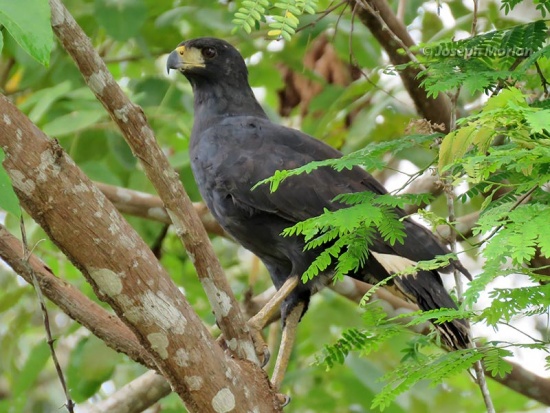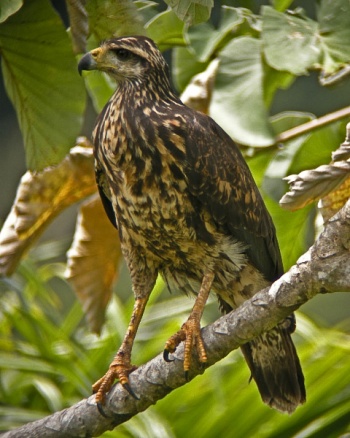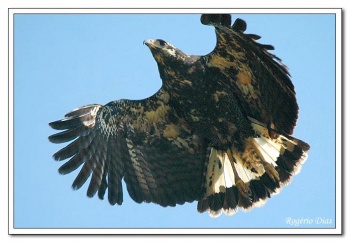| (9 intermediate revisions by 3 users not shown) | |||
| Line 1: | Line 1: | ||
| − | [[Image: | + | [[Image:GreatBlackHawkIMG 4981.jpg|thumb|550px|right|Adult, nominate subspecies<br />Photo © by {{user|jmorlan|Joseph Morlan}}<br />Rio Amazonas, Iquitos, [[Peru]], 9 June 2019]] |
;[[:Category:Buteogallus|Buteogallus]] urubitinga | ;[[:Category:Buteogallus|Buteogallus]] urubitinga | ||
==Identification== | ==Identification== | ||
| − | 51–64 cm<br /> | + | [[Image:Great Black-Hawk 124es.jpg|thumb|350px|right|Juvenile, nominate subspecies<br />Photo © by {{user|Dave+B+Smith|Dave B Smith}}<br />[[Tobago]], 20 March 2011]] |
| − | + | 51–64 cm (20-25 in)<br /> | |
| + | *Black overall plumage | ||
| + | *White on the base and the tip of the tail | ||
| + | *White rump | ||
| + | *Yellow legs and [[Topography#Heads|cere]] (latter greyish in Central America). | ||
| + | *May have barred tibials/thighs (esp. Central America) | ||
| + | *Longer tail than Common Black Hawk but shorter primary projection | ||
| + | ====Variations==== | ||
| − | Extent of white on tail and color of lores is variable; subspecies ''ridgwayi'' has two white bands on the tail, of which the upper is narrow and often concealed, and slaty | + | Extent of white on tail and color of [[Topography#Heads|lores]] is variable; subspecies ''ridgwayi'' has two white bands on the tail, of which the upper is narrow and often concealed, and slaty lores. This subspecies also often shows some white barring on thighs. |
| − | |||
====Similar species==== | ====Similar species==== | ||
| Line 22: | Line 28: | ||
==Habitat== | ==Habitat== | ||
Habitats from open country to forest but is normally to be seen near water. | Habitats from open country to forest but is normally to be seen near water. | ||
| − | |||
==Behaviour== | ==Behaviour== | ||
| + | [[Image:44584gavi oni.jpg|thumb|350px|right|Juvenile, nominate subspecies<br />Photo © by '''[http://www.birdforum.net/member.php?u=44584 Rogerio Araújo Dias]'''<br />Brasília, [[Brazil]], 24 August 2006]] | ||
| + | ====Breeding==== | ||
| + | Nests mostly in rainy season. The stick nest is usually placed in a tree or sometimes on a man-made structure. Clutch of one, rarely two white eggs with brown spots. | ||
====Diet==== | ====Diet==== | ||
| − | A wide variety of prey, including birds, rodents, land crabs, frogs and fish. They | + | A wide variety of prey, including birds, rodents, land crabs, frogs and fish. They are also known to eat fruit. Have been observed feeding in the company of caracaras and vultures. |
| + | =====Vocalisations==== | ||
| + | Common call is a long drawn-out high-pitched scream, very unlike the laughing call of [[Common Black Hawk]]. | ||
| + | ====Movements==== | ||
| + | Mostly sedentary; individuals of northern race may wander into Chocó of Colombia with at least one stray juvenile north to Maine, USA. | ||
| + | |||
| + | ==Gallery== | ||
| + | Click on photo for larger image | ||
| + | <gallery> | ||
| + | Image:Great Black Hawk2.jpg|Adult, subspecies ''urubitinga'' <br />Photo © by {{user|Stanley+Jones|Stanley Jones}}<br />Puerto Jofre, Mato Grosso, [[Brazil]], 5 August 2015 | ||
| + | Image:DSC 4394.JPG|Adult, subspecies ''ridgwayi''<br />Photo © by {{user|Gerald Friesen|Gerald Friesen}}<br />Yucatan, [[Mexico]], 10 February 2018 | ||
| + | </gallery> | ||
| + | |||
==References== | ==References== | ||
| − | #{{Ref- | + | #{{Ref-Clements6thAug18}}#Bierregaard, R.O., Jr, Boesman, P. & Kirwan, G.M. (2019). Great Black Hawk (''Buteogallus urubitinga''). In: del Hoyo, J., Elliott, A., Sargatal, J., Christie, D.A. & de Juana, E. (eds.). Handbook of the Birds of the World Alive. Lynx Edicions, Barcelona. (retrieved from https://www.hbw.com/node/53113 on 3 July 2019). |
| + | #Global Raptor Information Network. 2019. Species account: Great Black Hawk ''Buteogallus urubitinga''. Downloaded from http://www.globalraptors.org on 2 Jul. 2019 | ||
| + | #van Dort, J. (2019). Great Black Hawk (''Buteogallus urubitinga''), version 1.0. In Neotropical Birds Online (T. S. Schulenberg, Editor). Cornell Lab of Ornithology, Ithaca, NY, USA. https://doi.org/10.2173/nb.grbhaw1.01 | ||
{{ref}} | {{ref}} | ||
| + | |||
==External Links== | ==External Links== | ||
{{GSearch|Buteogallus+urubitinga}} | {{GSearch|Buteogallus+urubitinga}} | ||
Revision as of 20:17, 21 November 2019
- Buteogallus urubitinga
Identification
51–64 cm (20-25 in)
- Black overall plumage
- White on the base and the tip of the tail
- White rump
- Yellow legs and cere (latter greyish in Central America).
- May have barred tibials/thighs (esp. Central America)
- Longer tail than Common Black Hawk but shorter primary projection
Variations
Extent of white on tail and color of lores is variable; subspecies ridgwayi has two white bands on the tail, of which the upper is narrow and often concealed, and slaty lores. This subspecies also often shows some white barring on thighs.
Similar species
Compare with Common Black Hawk and the rare Solitary Eagle
Distribution
Central and South America: found from Mexico to Bolivia, Argentina, and Uruguay.
Taxonomy
Subspecies
There are two subspecies[1]:
- B. u. ridgwayi:
- B. u. urubitinga:
- Eastern Panama through South America to northern Argentina
Habitat
Habitats from open country to forest but is normally to be seen near water.
Behaviour
Breeding
Nests mostly in rainy season. The stick nest is usually placed in a tree or sometimes on a man-made structure. Clutch of one, rarely two white eggs with brown spots.
Diet
A wide variety of prey, including birds, rodents, land crabs, frogs and fish. They are also known to eat fruit. Have been observed feeding in the company of caracaras and vultures.
=Vocalisations
Common call is a long drawn-out high-pitched scream, very unlike the laughing call of Common Black Hawk.
Movements
Mostly sedentary; individuals of northern race may wander into Chocó of Colombia with at least one stray juvenile north to Maine, USA.
Gallery
Click on photo for larger image
Adult, subspecies urubitinga
Photo © by Stanley Jones
Puerto Jofre, Mato Grosso, Brazil, 5 August 2015Adult, subspecies ridgwayi
Photo © by Friesen Gerald Friesen
Yucatan, Mexico, 10 February 2018
References
- Clements, J. F., T. S. Schulenberg, M. J. Iliff, D. Roberson, T. A. Fredericks, B. L. Sullivan, and C. L. Wood. 2018. The eBird/Clements checklist of birds of the world: v2018. Downloaded from http://www.birds.cornell.edu/clementschecklist/download/
- Bierregaard, R.O., Jr, Boesman, P. & Kirwan, G.M. (2019). Great Black Hawk (Buteogallus urubitinga). In: del Hoyo, J., Elliott, A., Sargatal, J., Christie, D.A. & de Juana, E. (eds.). Handbook of the Birds of the World Alive. Lynx Edicions, Barcelona. (retrieved from https://www.hbw.com/node/53113 on 3 July 2019).
- Global Raptor Information Network. 2019. Species account: Great Black Hawk Buteogallus urubitinga. Downloaded from http://www.globalraptors.org on 2 Jul. 2019
- van Dort, J. (2019). Great Black Hawk (Buteogallus urubitinga), version 1.0. In Neotropical Birds Online (T. S. Schulenberg, Editor). Cornell Lab of Ornithology, Ithaca, NY, USA. https://doi.org/10.2173/nb.grbhaw1.01
Recommended Citation
- BirdForum Opus contributors. (2024) Great Black Hawk. In: BirdForum, the forum for wild birds and birding. Retrieved 24 April 2024 from https://www.birdforum.net/opus/Great_Black_Hawk
External Links








